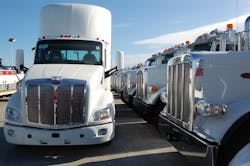Cliff-related “pause” seen developing in equipment investment
An annual outlook report on the equipment leasing and financing industry concludes that businesses have essentially “hit the pause button” on equipment and software investment until there is a resolution to the “fiscal cliff” – with the impact on the transportation industry decidedly mixed should no agreement be reached over tax increases and automatic spending cuts that make up the cliff.
“Our baseline growth forecast assumes a fiscal cliff deal that everyone can live with, [but] this is obviously a very fluid situation, and difficult to predict,” said Adam Karson, director of Keybridge Research LLC, whose firm helps compile the 2013 Equipment Leasing & Finance U.S. Economic Outlook in conjunction with the Equipment Leasing & Finance Foundation (ELFF).
In an interview by email with Fleet Owner, Karson explained that the going over the “cliff” would not affect transportation investment directly, though that by no means moves the industry out of harm’s way.
“Within the sequestration, there is no impact to the Highway Trust Fund; however, there are impacts to TIGER (Transportation Investment Generating Economic Recovery), Amtrak, and other public funding,” he noted. “As a result, the main direct impacts would come in the form of tighter state and local budgets, which may be forced to cut back on infrastructure projects.”
Karson said the difficult element is predicting how private sector transportation companies will react to the cliff.
“Will companies like UPS, FedEx, Werner Enterprises, and Union Pacific become pessimistic, cut back on investment, and try to extend the life of their existing assets? Depending on the private sector response, the hit to investment could indeed be significant,” he cautioned.
As a rough benchmark, Karson pointed to trends that occurred around the debt ceiling debate of 2011, when the growth rate for transportation equipment investment took a sudden dip.
“In the second quarter of 2011 the year-over-year growth rate was about 30%, [but] growth then slipped to 24% in third quarter and then popped back up to 30% in the fourth quarter,” he said. “Even assuming that the entire dip of 6 percentage points of growth – a 20% reduction in the growth rate – was attributable to the debt ceiling debate, we'd be looking at growth slowing from 10% to 8% over the next six months under a fiscal cliff scenario. Note that 10% to 8% is not an official forecast; just a ballpark estimate of the order of magnitude.”
Meanwhile, the ELFF’s outlook projects U.S. economic growth of 2.4% once major fiscal issues are resolved. Without a smooth solution to current fiscal challenges, growth is forecast to fall significantly below 2%, the group said.
Equipment and software investment took a significant hit in the third quarter of 2012, declining to an annualized rate of 2.7% after a 4.8% increase in the second quarter, while growth in transportation equipment investment is likely to moderate, averaging about 10% over the next three to six months, ELFF’s data showed.
Still, William Sutton, ELFF’s president and president and CEO of the Equipment Leasing and Finance Association, noted that looking forward into the third and fourth quarters of 2013, growth in equipment and software investment is expected to begin to regain momentum.
“If policymakers find a solution to key fiscal issues, we expect businesses will feel more confident in the second half of the year, leading to increased equipment investment,” he said.
One reason Keybridge’s Karson is also confident believes those trend lines indicate the potential for positive growth is that investment in transportation equipment tends to lag the business cycle; i.e., businesses do appear to stretch out the life of their transportation assets during recessions and then play catch-up once there is clear evidence of a recovery.
“At a high level – meaning not transportation-specific – businesses do appear to be ‘doing more with less’ with regards to equipment and software assets,” he said. “The Federal Reserve's Flow of Funds data shows that the ratio of equipment and software assets to GDP [gross domestic product] has averaged about 30% and 29% over the past 20 and 10 years, respectively. Currently, this ratio is running at 28%.”
Yet just a 1% shift in this ratio is equal to about $158 billion in nominal investment and – assuming this would be proportionally spread across equipment sectors – that would mean roughly $20 billion in "pent up demand" for transportation equipment, Karson noted.
“Before the Great Recession, transportation equipment investment peaked at an annual rate of $200 billion; we're now at $180 billion, so the $20 billion ‘hole’ seems about right,” he pointed out. “These are just ‘back-of-the-envelope’ calculations, but this is part of our overall story for why investment could pick up in the second half of 2013.”
About the Author
Sean Kilcarr
Editor in Chief
Sean Kilcarr is a former longtime FleetOwner senior editor who wrote for the publication from 2000 to 2018. He served as editor-in-chief from 2017 to 2018.
